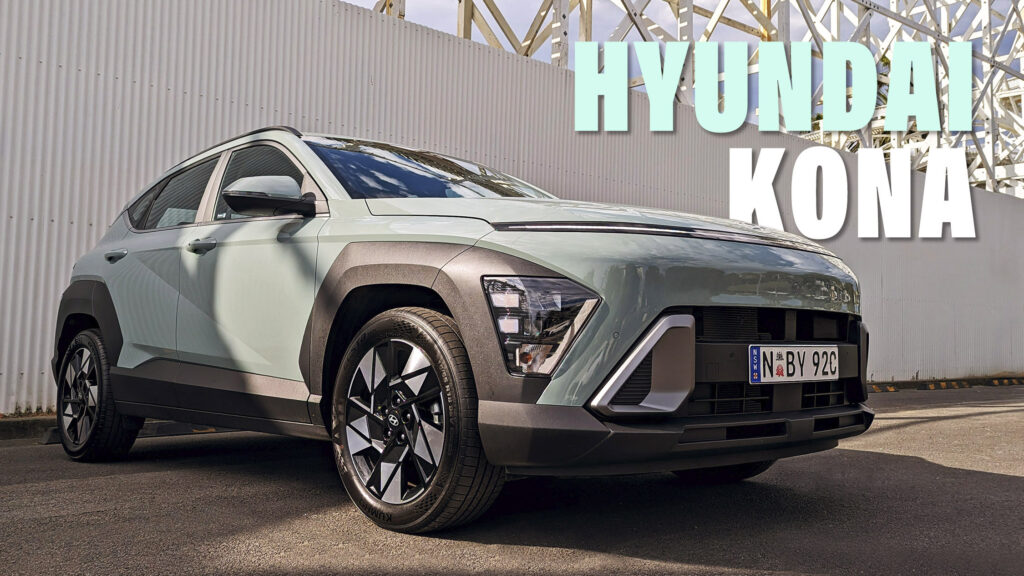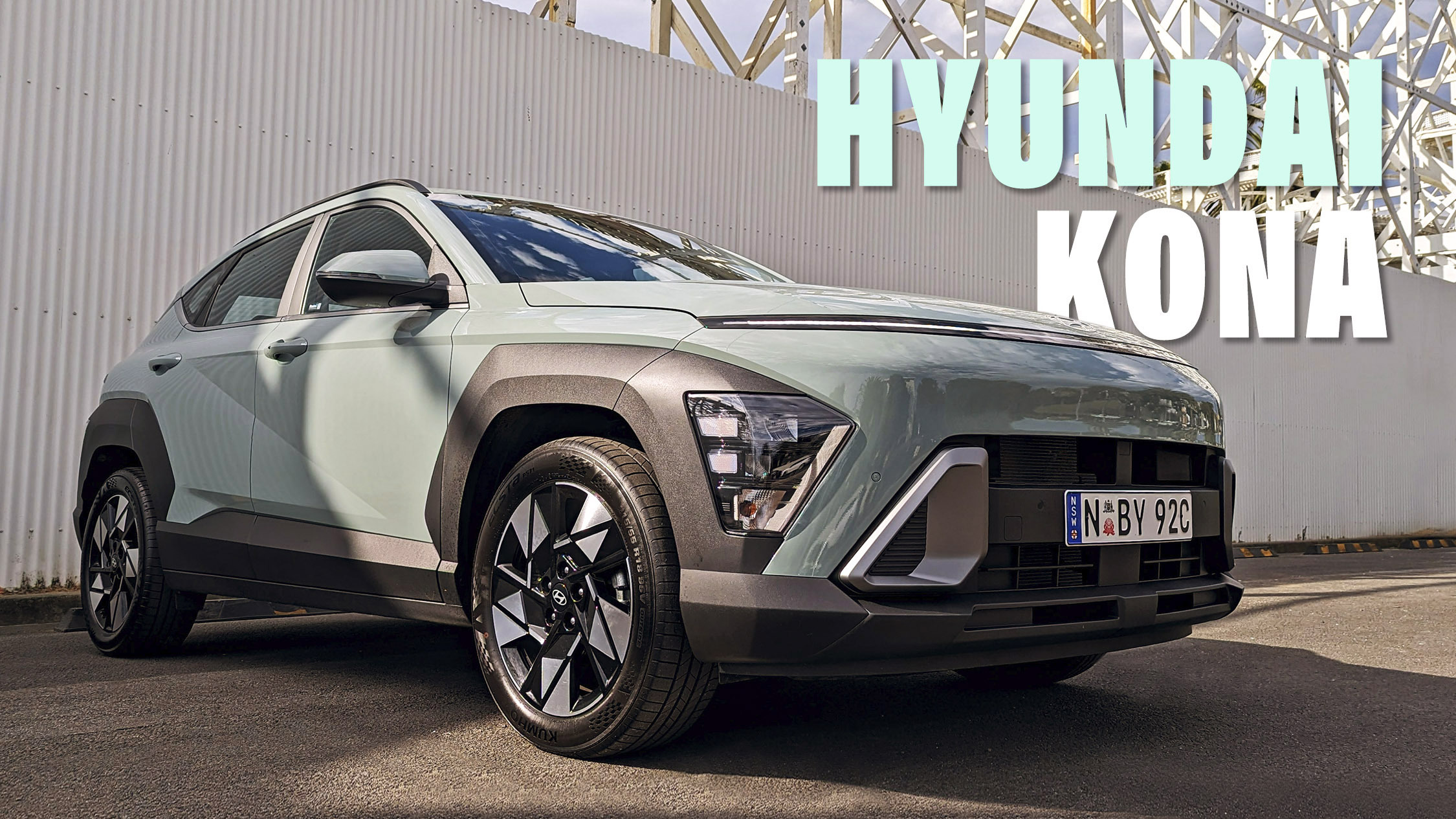We test the most affordable version of the new Kona to see how much it has matured in its non-electrified form
December 23, 2023 at 11:58

The Hyundai Kona received an overhaul for its second generation earlier this year, and now targets the upper end of the subcompact SUV segment with its larger footprint and more spacious cabin. We spent a couple of weeks in the base-spec version of the Kona with the 2.0-liter gasoline engine, in a quest to discover if the new model has enough charisma to stand out in a crossover-crowded world.
A More Futuristic Styling
The styling of the original Kona was kind of polarizing when it first came out in 2017, due to the split lighting units and the heavy dose of plastic cladding around the bodywork. The second generation presents these features in a more futuristic way, combining them with sharper surfacing and an EV-like stance. Another signature trait is the full-width LED bars on both ends. Finally, the standard 18-inch alloy wheels accentuate the modern style with their futuristic pattern.
Other options in the lineup include the the N Line trim that looks like a spaceship due to the body-colored cladding and the prominent aero, and the Kona Electric which also has a unique bodykit to differentiate itself from its ICE-powered and hybrid siblings. Overall, we believe that the standard Kona (SE in the US) and the higher-spec Kona Premium (Limited in the US) have the most sensible looks, at least for fans of crossover styling cues.
advertisement scroll to continue
More: 2024 Hyundai Kona Electric Starts At $32,675 And Offers Up To 261 Miles Of Range
While it still doesn’t look like a big car, the 2024 Hyundai Kona has a larger footprint compared to its predecessor. In combination with the sharper styling, it now looks more like a baby Tucson, while creating a safe distance from the smaller and cheaper Venue. To be precise, the Kona measures 171.3 (4,350 mm) long, 71.9 inches (1,825 mm) wide, and 62.4 (1,585 mm) tall, with a 104.7-inch (2,660 mm) wheelbase. This makes it 7.3 inches (185 mm) longer than the previous generation, with 2.3 inches (58 mm) of this extra length being added between the axles.
Spacious Cabin, Generous Standard Equipment
Inside, the upgrade compared to the original Kona in terms of design, technology, and available space, is evident at first glance. The centerpiece is the 12.3-inch infotainment display which looks crisp and has easy-to-navigate menus, while the wireless Android Auto (and Apple CarPlay) proved to work seamlessly every single time. The base-spec model we’re testing doesn’t have the 12.3-inch digital instrument cluster but the neatly integrated digital dials that change color depending on the drive mode (eco, normal, sport), and the basic 4.2-inch trip computer between them will do the job for most people.
The single row of shortcut buttons and knobs on the center console which is covered by faux aluminum trim is a nice touch, although their response could be faster. The toggle switches of the climate controls are always within reach, and the overall ergonomics are good. Having said that, I would prefer the electronic handbrake to be positioned in the center console instead of the right side of the steering wheel (RHD model).
The standard equipment of the entry-level Kona is excellent for the price point, as it includes features that you normally have to pay for, even in larger segments. Besides the 12.3-inch touchscreen, the base kit includes dual-zone A/C, wireless charging, four USB-C outlets, a six-speaker audio system that sounds surprisingly good (higher-spec models upgrade to an eight-speaker Bose audio), and a wide range of ADAS.
As for the available space for the rear passengers, you can feel the improvement compared to the outgoing Kona in both knee and headroom. The width has also been increased, contributing to an airy feeling in both rows. Finally, the boot can now hold a decent 407 lt (14.4 cubic feet) of cargo which is 33 lt (1.2 cubic feet) more than before. There is a practical net holding things in place and a space-saver spare tire underneath the boot floor. In-cabin practicality is average with four cupholders, a few small cubbies, a not-so-useful tray on the dashboard, bottle-friendly door pockets, and rear seats that fold flat.
One thing that shows the budget-friendly character of the Kona is the hard plastics that cover almost all of the interior surfaces. Hyundai designers tried to camouflage the scratchy material by adding fabric-style textures on the dashboard and faux aluminum trim on the center console. Still, there are many exposed areas on the doors and the lower part of the center console taking away from the high-end looks. For example, it would be nicer if there was a hint of soft-padded material on the door cards for the driver’s elbow. Thankfully, everything seems to be well put together as proven by the lack of squeaks and rattles when you fiddle around with the interior trim.
Civilized Road Manners, Not Enough Punch
Our entry-level Kona features the non-electrified naturally-aspirated 2.0-liter four-cylinder engine that makes 147 hp (110 kW / 150 PS) and 132 lb-ft (179 Nm) of torque. This powertrain is exclusively mated to a CVT gearbox sending power to the front wheels. Australian buyers miss out on the AWD option that is available in the US with the entry-level setup, although it is offered with the more potent turbocharged 1.6-liter engine of the Kona N Line.
advertisement scroll to continue
The engine and gearbox combination of the base model is more suitable for laid-back drivers, as the lack of a turbocharger to boost the low-end torque and the sluggish CVT make the Kona feel slower than numbers suggest. The Sport mode keeps the revs higher making the SUV slightly more eager to accelerate compared to the Normal and Eco settings which prioritize quietness and fuel consumption rather than performance. Instead of pushing the engine without the desirable outcome, I found myself using the Normal mode for most of my time with the Kona, adapting to the relaxed character of the powertrain. As a result, in a mix of urban and highway driving I averaged around 7.5lt / 100 km (MPG) which is not bad for a non-electrified vehicle of this size.
More: 2025 Hyundai Tucson Debuts With Updated Looks And All-New Interior
The 2024 Hyundai Kona is one of the few subcompact SUVs – alongside the Toyota C-HR and the VW T-Roc – which’s platform is derived from a compact hatchback rather than a supermini. Besides the spaciousness, this has a positive effect on the ride quality and the handling credentials. The suspension setup has a good balance between comfort and driving dynamics, with not much body roll in the corners. In the mostly freshly paved roads of Melbourne, the Kona’s springs felt plush over longer bumps, but the sharper road imperfections were noticeable inside the cabin. On the highway, the SUV exhibited superior ride and noise insulation compared to some rivals, making longer trips pleasant and relaxing.
As we mentioned earlier, the new Kona comes packed with ADAS, showing how far a subcompact SUV can go in terms of safety features, even in the cheapest available trim. During my time with the Korean SUV, the majority of the driver assistance worked great, improving safety for the occupants and other road users. The only downside is the constant beeps which can be irritating at times. These mostly originate from the driver monitoring camera which is very strict with keeping track of your eyes and can misjudge squinting against the sun for sleepiness. Another understandable but common case of beeping was going 1 km/h over the speed limit which is notoriously low in Australia and can happen even when the adaptive cruise control is set properly. However, some beeps and whistles are more than welcome, like the ones from the rear-cross-traffic alert system which are combined with vibrating pedals when a car approaches from the sides while you’re trying to reverse.
Rivals And Pricing
The 2024 Hyundai Kona has a pretty clever positioning, covering the middle ground between the subcompact (B-SUVs) and compact (C-SUVs) segments. For a good measure, it is longer than the global-spec Honda HR-V, Renault Captur, Peugeot 2008, and Dacia Duster, but 0.4 inches (10 mm) shorter than the Toyota C-HR.
From a price point perspective, the new Kona can be a value-for-money proposal depending on the market and the trim. In Australia, the 2024 Hyundai Kona 2.0 CVT starts from AU$32,000 (US$21,066) before on-road costs and this is the actual price of the pictured press car. While there are cheaper small and subcompact SUVs out there, the technology, practicality, and well-rounded character of the Kona make it a compelling option at this price point. Still, with the more powerful and fuel-efficient 2024 Hyundai Kona Hybrid starting at AU$36,000 (US$24,348), I would probably spend the extra AU$4,000 (2,705) for the electrified model which is significantly cheaper than the mechanically related Kia Niro Hybrid.
As far as other markets go, the equivalent US-spec 2024 Hyundai Kona SE with the same engine and gearbox configuration has a starting MSRP of US$24,100 excluding destination charges. Buyers in the Old Continent don’t have access to this setup but the indicative starting price of the entry-level turbo 1.0-lite EU-spec Kona in Germany is €26,900 ($29,344).
Verdict
The 2024 Hyundai Kona is a thoroughly improved subcompact SUV that currently sits among the best options in the segment. It drives well, looks interesting, and has plenty of room inside, while the generous equipment of the entry-level trim makes it a value-for-money proposal. On the downside, the lack of excitement from the naturally aspirated 2.0-liter engine and the CVT gearbox steal the limelight from the capable chassis, making the slightly pricier but cheaper to run Kona Hybrid a wiser choice for most drivers.
